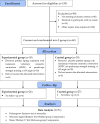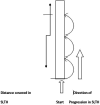The effect of patellar taping combined with isometric strength training on pain, muscle strength, and functional performance in patients with patellofemoral pain syndrome: a randomized comparative study
- PMID: 40376557
- PMCID: PMC12080477
- DOI: 10.7717/peerj.19381
The effect of patellar taping combined with isometric strength training on pain, muscle strength, and functional performance in patients with patellofemoral pain syndrome: a randomized comparative study
Abstract
Background: Patellar taping and quadriceps strengthening exercises are commonly used in physiotherapy to manage patellofemoral pain syndrome (PFPS). However, previous research has reported inconsistent findings regarding quadriceps strength gains at specific knee angles during strength training in individuals with PFPS.
Objectives: This study investigated the efficacy of patellar taping and quadriceps isometric strength training (quadriceps-IST) at 60° knee flexion on quadriceps strength, pain, and functional performance in female patients with PFPS.
Methods: A two-arm, parallel-group, randomized comparative design was employed. Sixty adult females with PFPS were randomly assigned to either the experimental group (n = 30), which received patellar taping combined with quadriceps strength training at 60°, or the control group (n = 30), which received placebo taping with the same training. Both interventions lasted six weeks. Pain intensity, quadriceps muscle strength, and functional performance were assessed using the numeric pain rating scale (NPRS), maximum voluntary isometric contraction (MVIC) at 60° knee flexion, single leg triple hop (SLTH) test, and anterior knee pain scale (AKPS). For within and between groups comparison, a Wilcoxon signed-rank test and a Mann-Whitney U tests was employed, with confidence interval (α) set at 95%.
Results: Within-group analysis showed significant improvements in NPRS and MVIC at 60° knee flexion, SLTH, and AKPS scores post-intervention (p < 0.05). Between-group comparisons revealed that the experimental group had significantly greater improvements in all outcomes at six weeks post-intervention. Additionally, the pre-to-post changes (i.e., mean difference scores) were larger in the experimental group compared to the control group, which confirmed the superiority of the experimental group over the control group.
Conclusions: The study demonstrates that patellar taping combined with quadriceps -IST at a 60° knee flexion improves pain, muscle strength, and functional performance compared to placebo taping combined with quadriceps-IST. These findings suggest that incorporating this combined approach may enhance rehabilitation outcomes for patients with PFPS, providing a valuable addition to clinical practice.
Trial registration: This study was registered prospectively in the ClinicalTrials.gov PRS under a trial identifier NCT05168332 and last updated date 15/03/2024.
Keywords: Anterior knee pain scale (AKPS); Knee pain; Maximum voluntary isometric contraction (MVIC); Numeric pain rating scale; Pain; Patellofemoral pain syndrome; Strength.
©2025 Hasan.
Conflict of interest statement
The authors declare there are no competing interests.
Figures








Similar articles
-
Efficacy of Patellar Taping and Electromyographic Biofeedback Training at Various Knee Angles on Quadriceps Strength and Functional Performance in Young Adult Male Athletes with Patellofemoral Pain Syndrome: A Randomized Controlled Trial.Pain Res Manag. 2022 Aug 1;2022:8717932. doi: 10.1155/2022/8717932. eCollection 2022. Pain Res Manag. 2022. PMID: 35958675 Free PMC article. Clinical Trial.
-
Efficacy of Electromyographic-Biofeedback Supplementation Training with Patellar Taping on Quadriceps Strengthening in Patellofemoral Pain Syndrome among Young Adult Male Athletes.Int J Environ Res Public Health. 2021 Apr 23;18(9):4514. doi: 10.3390/ijerph18094514. Int J Environ Res Public Health. 2021. PMID: 33922866 Free PMC article. Clinical Trial.
-
The effects of quadriceps strengthening on pain, function, and patellofemoral joint contact area in persons with patellofemoral pain.Am J Phys Med Rehabil. 2012 Feb;91(2):98-106. doi: 10.1097/PHM.0b013e318228c505. Am J Phys Med Rehabil. 2012. PMID: 22248804
-
A review of the management of patellofemoral pain syndrome.Phys Sportsmed. 2013 Sep;41(3):19-28. doi: 10.3810/psm.2013.09.2023. Phys Sportsmed. 2013. PMID: 24113699 Review.
-
Efficacy on pain and knee function of Kinesio taping among patients with patellofemoral pain syndrome: a systematic review and meta-analysis.BMC Musculoskelet Disord. 2025 Apr 21;26(1):388. doi: 10.1186/s12891-025-08627-7. BMC Musculoskelet Disord. 2025. PMID: 40259274 Free PMC article.
References
-
- Alba-Martín P, Gallego-Izquierdo T, Plaza-Manzano G, Romero-Franco N, Núñez Nagy S, Pecos-Martín D. Effectiveness of therapeutic physical exercise in the treatment of patellofemoral pain syndrome: a systematic review. Journal of Physical Therapy Science. 2015;27(7):2387–2390. doi: 10.1589/jpts.27.2387. - DOI - PMC - PubMed
-
- Alghadir AH, Anwer S, Iqbal A, Iqbal ZA. Test–retest reliability, validity, and minimum detectable change of visual analog, numerical rating, and verbal rating scales for measurement of osteoarthritic knee pain. Journal of Pain Research. 2018;11:851–856. doi: 10.2147/JPR.S158847. - DOI - PMC - PubMed
-
- Alonazi A, Hasan S, Anwer S, Jamal A, Parvez S, Saleh Alfaiz FA, Li H. Efficacy of electromyographic-biofeedback supplementation training with patellar taping on quadriceps strengthening in patellofemoral pain syndrome among young adult male athletes. International Journal of Environmental Research and Public Health. 2021;18(9):4514. doi: 10.3390/ijerph18094514. - DOI - PMC - PubMed
Publication types
MeSH terms
Associated data
LinkOut - more resources
Full Text Sources
Medical

